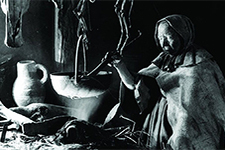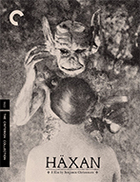Haxan (aka Witchcraft Through the Ages)
|  Pioneering Danish filmmaker Benjamin Christensen’s name doesn’t appear in a lot of general film histories, even though it should. He made 14 films from the 1910s through the early ’40s, including his first two, The Mysterious X (1913) and The Night of Revenge (1915), which are as technically innovative and stylistically advanced as anything American directors such as D.W. Griffith and Cecil B. DeMille were doing at the time. Without doubt Christensen’s most notorious films is his 1922 “documentary” Häxan, a bizarre silent-film oddity that explores the nature of witchcraft and diabolism from ancient Persia through then-modern times using a variety of cinematic approaches, from still images, to models, to vivid, dramatic reenactments. It is a hard film to pin down, and it defies any boundaries of genre, especially that of the documentary film, which in the early ’20s was still amorphous and undefined. Part earnest academic exercise in correlating ancient fears about witches with misunderstandings of mental illness, and part salacious horror movie, Häxan is a truly unique work that still holds the power to unnerve even in today’s jaded era. Divided into seven sections, Häxan delves deep into the world of religious superstition and paranoia. It begins in an educational lecture format, cutting together shots of ancient wood carvings, paintings, and engravings with numerous, lengthy intertitles explaining the origins of the belief in witches and devils. The images have an undeniable potency, especially when the film shifts to dramatic reenactment, and we realize that Christensen’s visual approach is based on giving those still images three-dimensionality and motion. This exploration of past fears that is often tinged with condescending enlightenment-oriented scientism, but one can’t completely fault Christensen’s point of view, as his film is a direct product of its time, when the wonders of the modern era were still rich with the naïve beliefs that scientific rationality could explain everything. Christensen sometimes tempers this tendency with fleeting suggestions that perhaps there is something to the belief in demons and witches, even if it is firmly rooted in the minds of those who fear them. The surface of Häxan is deadly earnest, even if the startling visuals border on the pornographic, in the sense that they exist for their own salacious appeal. Christensen fills the frame with every frightening image he can conjure out of the historical records, often blending fact and fantasy in a way that makes the two inseparable. We get images of a haggard old witch pulling a severed, decomposing hand out of a bundle of sticks and snapping off one of the fingers in order to brew a potion. There are shocking moments in which we witness a woman giving birth to two enormous demons, see a witches’ sabbat, and endure tortures by inquisition judges. We see an endless parade of demons of all shapes and sizes, some of whom look more or less human (including one played by Christensen himself) except for their excessive hair and horned scalps, while others are almost fully animal—pigs, twisted birds, cats, and the like. While many silent-era movies look hokey and fake to today’s audiences, the make-up effects used in Häxan are startlingly realistic and effective. Christensen employs a number of in-camera devices to suggest the supernatural and the fantastical, including an excellent and too-brief bit of stop-motion animation, multiple exposures to create the image of witches flying through the air, large and detailed models, and the kinds of prosthetic make-up effects that were thought to have been brought to perfection in the horror films of the 1970s, but here look just as good in hand-tinted black and white. Christensen was certainly a cinematic visionary, and he had a keen notion of the powerful effects of mise-en-scene. While Häxan is often cited as a forerunner of the devil-possession films of the ’70s like The Exorcist (1973), I found myself constantly reminded of Tobe Hooper’s effective use of props and background detail in The Texas Chainsaw Massacre (1974) to create an enveloping atmosphere of potential violence. Häxan is a film that needs to be viewed more than once to gain a full appreciation of the set design and decoration—the eerie use of animal skeletons, cauldrons, and human skulls, as well as claustrophobic sets and chiaroscuro lighting to set the tone. It is not surprising, then, that the surrealists and later the followers of the avant-garde found so much to admire in this film. Bordering on the incoherent but also deeply engrossing, Häxan is a film made to shock and outrage, to challenge and subvert, even if its all-too-easy psychoanalytic correlation of witches and female hysteria seems as dated and silly as the ancient superstitions themselves. In fact, Häxan has circulated most widely since the late 1960s under the title Witchcraft Through the Ages, which is a shortened version edited and produced by British filmmaker Antony Balch that features a dry narration by Beat novelist William S. Burroughs and a funky, wholly unsuitable jazz score. This presents a fascinating case history of the way in which a film has transcended both time and meaning, its creepy imagery reimagined in different times as camp and parody. But, viewing Christensen’s full version today, one cannot wholly dismiss it as inadvertent humor and intentional gross-out. Rather, Häxan makes a bold statement using titillating and disturbing imagery, the power of which has not been completely diminished even after nearly a century. Even if Christensen’s conclusions are faulty, his cinematic techniques and understanding of the inherent power of the medium imbues Häxan with a rare timelessness. That is some kind of achievement and certainly evidence that Christensen deserves a more prominent place in the history books.
Copyright © 2019 James Kendrick Thoughts? E-mail James Kendrick All images copyright © The Criterion Collection | |||||||||||||||||||||||||||||||
Overall Rating: 


 (3.5)
(3.5)


